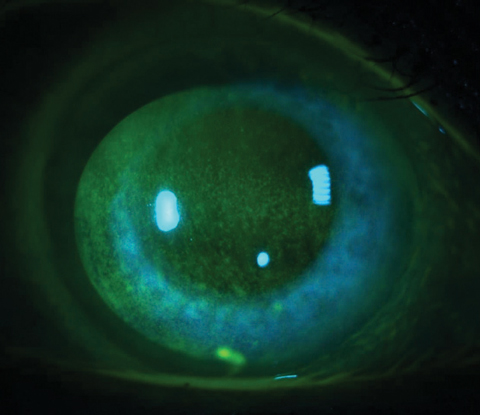 |
| BAK-preserved drops kill off more goblet cells than drops without preservatives. Photo: Jacob R. Lang, OD. Click image to enlarge. |
It’s commonly understood that benzalkonium chloride (BAK), used chronically, can have toxic effects on the ocular surface. To illuminate the specific mechanisms at work, a new study examined the effect of BAK-preserved latanoprost eye drops on human goblet cell (GC) viability and mucin release. Researchers tested seven preserved formulations (Xalanan and six generics), plus one preservative-free latanoprost formulation and compared the eye drops’ physicochemical properties.
Primary GC cultures were established from human conjunctival donor tissue after exposure to Xalatan, and the impact of eye drops on GC survival was assessed using a lactate dehydrogenase assay. Mucin release was evaluated through mucin-specific immunostaining, and pH value, osmolality, drop mass and surface tension for all eye drops were measured.
Thirty minutes after application of the preservative-free drop, GC survival was maintained compared with controls, while all BAK-preserved drops reduced survival by approximately 30%. Mucin was found around the GC nucleus, as seen in the vehicle control, which indicated no secretion. In contrast, BAK caused diffuse staining of mucin, similar to the secretagogue histamine, indicating stimulation of secretion.
The non-preserved formulation “proved to be non-cytotoxic while all the BAK-preserved eye drops caused significant GC death,” the researchers wrote in their paper on the study. This confirms the toxicity of BAK-preserved eye drops, an association researchers previously found with the concentration of BAK in IOP-lowering eye drops with different active ingredients.
Incubation with Xalatan appeared to cause mucin release similar to the known GC agonist histamine, which was not seen for the preservative-free option and could indicate an irritant effect of preserved eye drops, the authors noted. “The effect of PG and BAK on mucin secretion has not been rigorously investigated, and studies on the mechanism of BAK’s secretagogue effect would be of interest,” they explained. “Of note, the current results are qualitative, and quantitative measurements are needed to confirm these results. Furthermore, GCs may act differently when cultured compared with in vivo. The current setting is static, while in vivo, the eye drop concentration would continuously decrease and not be constant for 30 minutes.”
The pH value of Xalatan was notably low—6.0—compared with the generic BAK-preserved eye drops as well as the preservative-free version. “Our results show that one cannot assume that the branded Xalatan and generics hereof are similar with regard to pH value,” the authors explained. The generics and the non-preserved drug all “had pH values closer to the tear film compared with Xalatan and may, therefore, have better tolerability.”
The study concluded that preservative-free latanoprost eye drops are superior to BAK-preserved agents with regard to cultured GC viability and mucin release, but noted that clinical studies are needed to identify whether these findings can be verified in vivo, the authors noted.
Mullertz O, Hedengran A, Mouhammad ZA, et al. Impact of benzalkonium chloride-preserved and preservative-free latanoprost eye drops on cultured human conjunctival goblet cells upon acute exposure and differences in physicochemical properties of the eye drops. BMJ Open Ophthalmol. December 20, 2021. [Epub ahead of print]. |

